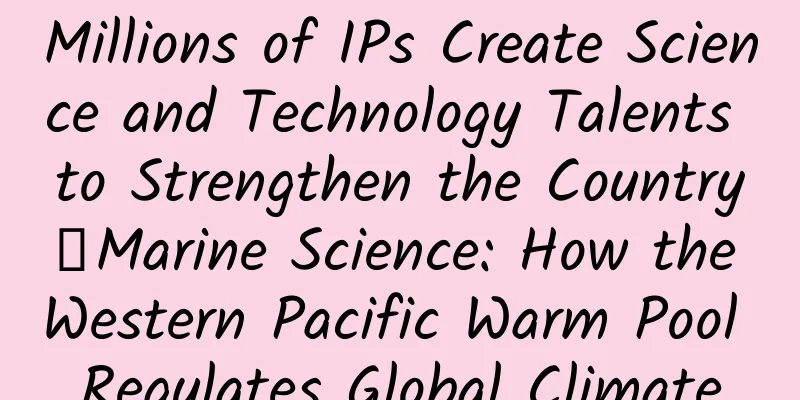Millions of IPs Create Science and Technology Talents to Strengthen the Country丨Marine Science: How the Western Pacific Warm Pool Regulates Global Climate

|
As the largest heat reservoir in the Earth's climate system, the ocean plays a vital role in regulating the global climate. Understanding the mechanisms of changes in ocean heat content and its impact on the global climate system requires long-term records of geological conditions to supplement the inadequacy of instrumental observation data. On October 19, 2022, Nature magazine published online an important scientific research achievement of the team of Professor Jian Zhimin from the State Key Laboratory of Marine Geology of Tongji University. This achievement is the result of the team's many years of research on the paleoceanography of the subsurface seawater in the western Pacific Warm Pool. They discovered that the ocean heat content in the warm pool area can regulate the water vapor transfer between the Asian continent and the Pacific Ocean. This study not only provides a new explanation for the water cycle of the global monsoon and the water vapor dynamics of Asian stalagmites, but also opens up a new field of paleoceanography. The warm pool (a warm ocean area) is like a huge hot water bag that can affect the surrounding climate. When it gets hotter, it causes more water vapor to drift to the Asian continent, causing rain there; conversely, when it cools, rainfall in the Asian continent decreases. This study is like a key that opens the door to understanding the secrets behind this process and helps us better understand how climate change occurs. This study not only provides a new perspective for understanding the water cycle of the global monsoon, but also opens up a new field of paleoceanography, which is of great significance for understanding climate evolution. The study used geochemical analysis of the shells of planktonic foraminifera to reconstruct changes in ocean heat content in the upper layer (0-200 meters) of the Western Pacific Warm Pool over the past 360,000 years. Planktonic foraminifera are tiny organisms widely distributed in the ocean, and their shells contain information reflecting the temperature of the sea water at that time. By conducting geochemical analysis of these shells, changes in ocean temperature in history can be indirectly inferred. This study is very interesting. Scientists took out ten cores like time capsules from the deep sea, which contained many tiny marine shell fossils. Scientists measured the proportion of chemical components in these shells, just like using the "identity card" of the shells to understand the temperature of the ancient ocean. They found that since the past 360,000 years ago, the temperature of the upper seawater in the warm pool area has changed regularly, mainly in a cycle of every 20,000 years, sometimes accompanied by small fluctuations every 40,000 years. These changes are due to changes in the angle of sunlight that affect the distribution of heat in low-latitude areas, thereby changing the deep water circulation of the ocean. Even more surprising is that the study also found that the seawater heat in the warm pool area appeared three particularly high periods in these 360,000 years, about once every 100,000 years. At this time, the sun's radiation and the changes in the Earth's orbit acted together to make the warm pool hotter, and at the same time, some of the ice on the Earth melted, increasing the global seawater heat. This study is very similar to the results of a supercomputer model called CESM simulation, just like a real experiment and a virtual experiment The results coincide. In addition, scientists also "know" the oxygen isotope changes in the surface seawater of the ancient warm pool through shell fossils, which is also similar to the stalagmite records from Chinese caves. The oxygen isotope changes on stalagmites can tell us information about ancient rainwater. Simply put, when the warm pool becomes hotter, the seawater there evaporates more, making the oxygen isotopes in the seawater heavier, while the adjacent land becomes more humid due to the increase in rain brought by the monsoon, and the oxygen isotopes in the rainwater are relatively light. This is like an ocean "water tower". The thermal changes in the warm pool can control the evaporation of seawater and its transport to the land, and strengthen the exchange of water vapor and heat between the ocean and the land. When the warm pool gets hotter, it acts like a more powerful water pump, pushing more water vapor toward the land, increasing monsoon rainfall. This is like a clever mechanism of nature that keeps the ocean and land closely connected and jointly regulates the Earth's climate. The research results have received widespread attention from academia and society. It not only deepens people's understanding of changes in ocean heat content and its impact on the climate system, but also provides new perspectives and directions for future research. Author: Zhu Yehua, PhD in Environmental Science, Tsinghua University Reviewer: Liu Yuankun, Associate Professor, Beijing University of Technology |
Recommend
Implementing system sound recording in Android-RK3399 development board source code modification
Preface I have been recording system sound these ...
Studio-grade recording quality RAZER Magic Siren Microphone
CARLSBAD, Calif., December 11, 2014 – Razer™, a w...
From Roewe RX5 to MG ZS, why are Alibaba's Internet cars more reliable than Tesla?
Alibaba, which recently teamed up with Roewe to l...
Two key steps to attract new users and retain users on e-commerce apps!
In the second half of the mobile Internet, it has...
How to quickly increase fans on Kuaishou? What should I pay attention to when increasing followers?
This article mainly introduces how to quickly inc...
Fatal attraction! Why are we so obsessed with black holes?
When you stare into the abyss The abyss is also s...
What is the cost-effective configuration for renting a gaming website server?
What is the cost-effective configuration for rent...
What does the "how" in Baidu bidding mean? How to modify the title of Baidu bidding method?
How to apply for Baidu Xijing? Can a general acco...
Baidu launches autonomous vehicle travel service platform "Robot Run", and the blueprint for autonomous driving is finally implemented
On August 18, the 15th Baidu World Conference 202...
A complete manual for new media operations: detailed explanations of how to use Bilibili, Zhihu, Xiaohongshu, etc.
Lei Jun, chairman of Xiaomi, opened a Xiaohongshu...
The earth beneath our feet is more than just “rustic”!
If we were to transform into an ant-sized creatur...
From CTR 0.5% to CTR 7%, share 3 great promotion ideas!
A few days ago, I wrote an article about informat...
10,000-word analysis: How the top 10 platforms use red envelopes to increase user growth during the 2020 Spring Festival
Every Spring Festival, the red envelope strategy ...
Online event promotion planning and solution analysis
For operators, event operation is a very importan...
User Operations: Are you sure you really understand user portraits?
When people perceive things, they always like to ...









